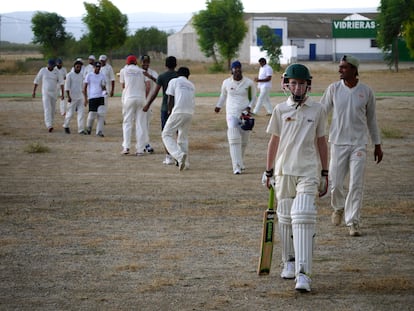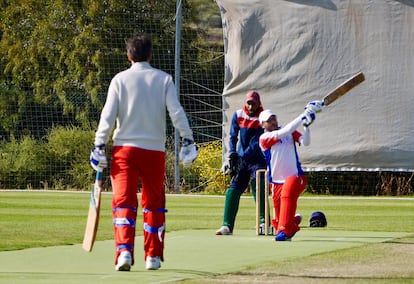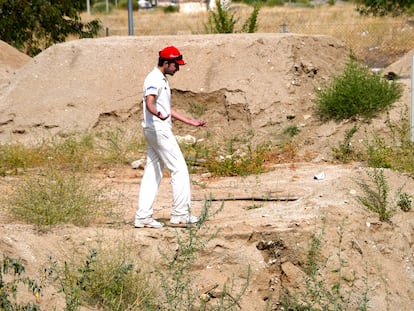The never-ending challenge of playing cricket in Madrid
There is no proper field in the city, but hundreds of players from various teams do their best to play the second most popular sport in the world


It all started with a small ad in a Madrid newspaper inviting anyone who wanted to play cricket to get in touch. It was the summer of 2001 and a few Englishmen responded and got together one Sunday afternoon to play cricket on an asphalt court in the Estrella neighborhood of the Retiro district. There are now three active teams in the city – and a few others that are more informal – bringing together around 150 players of more than 14 nationalities to play the world’s second most popular sport. However, 20 years later, there is still no proper field in the city. Even so, Madrid’s teams still manage to play: some still do so with tennis balls and plastic bats on basketball courts. While the Madrid Cricket Club (MCC), the most organized team, plays in a league against clubs from other cities, but its home matches are played in La Manga in Murcia.
The current president of MCC, Jon Woodward, refounded the club after that Sunday in 2001. “The club is the oldest in Spain. It was started in the 1960s by a Briton after getting some equipment from the [British] Embassy. But in the 1990s it disappeared and there were only a few teams left on the coast,” says Woodward, who has researched the history of the sport in Spain since he has been in charge of the club. From then on, players started getting together for informal matches on a regular basis, as a way of socializing and speaking a bit of English. But the goal was always bigger.

Cricket is played on an oval field, which is roughly equivalent to two football pitches. Batting is done from the center, on a rectangle with a firmer surface, similar to a golf green. In addition, the ball is particularly hard, so protective material is also needed. The first thing the newly reformed MCC did was to buy this equipment. The next mission was to find the pitch. In the meantime, they helped launch the East Coast and Central League, of which they are a part of to this day.
The first place in Madrid they managed to get access to, back in 2004, was the football pitch of the British Council School in Somosaguas in the municipality of Pozuelo de Alarcón. The cricketers trained there and played some friendlies, but the space was too small for an official match. In 2010, they started to play on a rugby field at the King Juan Carlos University in Alcorcón, where they had two full teams, until the financial crisis led to the closure of the sports center. Since then, they have been training on tennis courts at Madrid‘s Complutense University, although since the pandemic began they have not been able to return.
About six years ago they tried to adapt a pitch in Sonseca in Toledo. But the conditions were deplorable: a wasteland next to a sports center, uneven and dry, without grass and with stones and even glass on the outfield. There were no toilets, no water, and no shade. But as it was the only place they could find, they persevered and played a little Madrid league. They still organize matches there from time to time against teams that are not in the league on the coast because they can’t afford to travel.

The Sonseca “pitch” reflects the dedication and hopelessness of Madrid’s cricketers after two decades of looking for someone who will pay attention to them. “I can’t tell you how many town halls we have approached. We are not looking for money, just the space. We would pay for the installation of the wicket [the central rectangle, which can be asphalted and covered with a special mat] and the maintenance. We’re willing to pay rent as well, but we haven’t been able to move forward,” says Woodward.
They are usually dismissed because they think cricket is a sport for guiris – a colloquial word used in Spain to describe foreign tourists, particularly from northern Europe. That’s despite the fact that most of the players are of Indian, Pakistani and Bengali origin. On another occasion, local authorities tried to take advantage of the cricketers’ plight. “They asked us for plans for the pitch – a simple oval with a rectangle in the middle – but we had to have them drawn up by the councilor’s brother-in-law’s architect firm at a cost of €5,000. We refused and they never got back to us,” continues Woodward, indignantly.
Now, in a bid to secure a field, the Madrid cricketers are hopeful they will be able to federate on a national scale, as is already the case in Catalonia. But this too has been a lengthy bureaucratic process. “When we started the league, cricket was only recognized as a hobby in Spain. In 2010, we managed to get it recognized as a sport, and since then we have been in the process of federation,” explains the MCC president. The cricketers have been fulfilling the requirements of the Sports Ministry for more than 10 years, only to have more demands placed on them, complains Woodward. First, there had to be 30 registered teams in the country; then 40, in five different regions; then 80 and a children’s game program. Last time authorities also asked for women’s teams. The cricketers managed to organize this and are now waiting for a response.

On this occasion, there is a glimmer of real hope. “Every time we go they raise the bar because, we understand, if they federate the sport they are obliged to invest money in it. But we have already fulfilled all the requirements, they can’t ask us for more,” explains Woodward. In Catalonia, for example, a women’s team has managed to win support for its proposal to renovate a municipal football pitch into a cricket one; it would be the fourth in the area to cater to the 400 players there. “There are quite a few advantages to being federated,” explains Woodward. “Not just money. Mainly, for us, it would give us the credibility to get some local council to help us, because now nobody even knows what cricket is.”
Tu suscripción se está usando en otro dispositivo
¿Quieres añadir otro usuario a tu suscripción?
Si continúas leyendo en este dispositivo, no se podrá leer en el otro.
FlechaTu suscripción se está usando en otro dispositivo y solo puedes acceder a EL PAÍS desde un dispositivo a la vez.
Si quieres compartir tu cuenta, cambia tu suscripción a la modalidad Premium, así podrás añadir otro usuario. Cada uno accederá con su propia cuenta de email, lo que os permitirá personalizar vuestra experiencia en EL PAÍS.
¿Tienes una suscripción de empresa? Accede aquí para contratar más cuentas.
En el caso de no saber quién está usando tu cuenta, te recomendamos cambiar tu contraseña aquí.
Si decides continuar compartiendo tu cuenta, este mensaje se mostrará en tu dispositivo y en el de la otra persona que está usando tu cuenta de forma indefinida, afectando a tu experiencia de lectura. Puedes consultar aquí los términos y condiciones de la suscripción digital.
More information
Últimas noticias
Most viewed
- Reinhard Genzel, Nobel laureate in physics: ‘One-minute videos will never give you the truth’
- Oona Chaplin: ‘I told James Cameron that I was living in a treehouse and starting a permaculture project with a friend’
- Pablo Escobar’s hippos: A serious environmental problem, 40 years on
- Charles Dubouloz, mountaineering star, retires at 36 with a farewell tour inspired by Walter Bonatti
- Why we lost the habit of sleeping in two segments and how that changed our sense of time









































